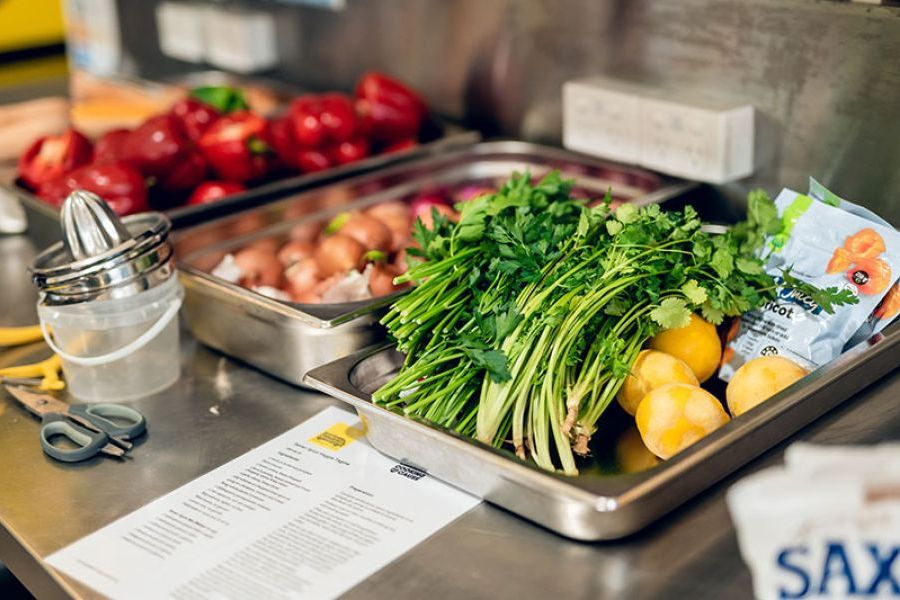
The problem
Students lack knowledge about agriculture and where the food they eat every day comes from. As a result, they are often unaware of the value of food and waste it. Some also do not know how to prepare simple healthy meals with fresh ingredients.
The solution we used
In this activity, students will go through the Farm to Fork, or "Field to Plate," strategy step by step. They will go from finding local farmers to getting to know the farmers and their products, then use these products to prepare seasonal and local dishes. In this way, they will literally experience the "Field to Plate" strategy.
Tools or equipment needed: depending on the different stages
- Computers with internet connection, office supplies
- Space suitable for preparing and serving food and drinks from the cold kitchen (school canteen)
- basic tools for preparing food and drinks in the cold kitchen (plates, trays, knives, forks, spreading bowls, glasses, )
- recyclable or borrowed porcelain, wooden or stainless steel crockery for serving food and drinks
Implementation
The activity aims to create a relationship of responsibility towards a sustainable food system and to make students aware of their individual role in it. Therefore, it is implemented in gradual steps over a period of about 3-4 months and is carried out in stages:
- Finding and promoting local food producers and suppliers
- Field trips to selected farms
- Use of local and seasonal ingredients in the preparation of food and beverages for the cold buffet
- Offer:
- Cold cuisine (bread, chutneys, sandwiches, spreads, cheese rolls, stuffed eggs, stuffed vegetables, fruit skewers, fruit cups, sliced fruit)
- drinks - fruit juices, smoothies
- evaluation: serving - food garnishing, presentation, consumption and economic aspects
The activity aims to create a relationship of responsibility for a sustainable food system and to make students aware of their individual role in it. Students took the initiative to seek out local food producers, got to know some of them and formed a personal bond with them. They used websites to find local farmers, but there is also the possibility that they might find a farmer with whom their family already has a good experience.
By buying and using the farmer's products, they will support their competition in the food distributor environment. Food from specific farmers and seasonal and local foods from other sources were used to prepare the cold buffet.
Students work in groups to select recipes to implement from several menu or cold buffet meal suggestions. In addition to the technological quality of the processing of the ingredients, they will also focus on the economic value of the ingredients when preparing the dishes.
Here we offer some recipes which our students followed for your inspiration.
Toast with cheese and roasted tomatoes
Preparation:
- Spread the washed tomatoes on a tray, salt them, add sugar, oil and mix everything well.
- Place the tomatoes in an oven heated to 220ºC for approximately 15 to 20 minutes. They should be slightly "wrinkled" and some even cracked.
- In the meantime, fry the sliced bread in a dry pan until golden brown on both sides.
- Rub the hot toast with cleaned cloves of garlic and spread with a flash spread, which we mixed from bryndza, sour cream and a pinch of freshly ground black pepper.
- Place roasted tomatoes and basil leaves on top of the sandwiches and lightly drizzle with olive oil.
- Marinovaný a pečený ovčí syr
Marinated and baked sheep's cheese
Preparation:
- Put oil, lemon juice, honey, dried oregano, parsley, grated garlic and onion in a bowl. Put everything together in the marinade. We leave it in the marinade for 1 day. The next day, preheat the oven to 180 ºC.
- Drain the cheese and put it in the oven. Drizzle the sheep's cheese with olive oil, sprinkle with salt and thyme and place the pan in the oven.
- After 20-30 minutes, remove the pan and serve.
Frozen yogurt temptation
Preparation:
- Line the sheet with baking paper, thanks to which we can easily remove the yogurt bars later.
- Mix yogurt with sugar, vanilla extract and salt in a bowl.
- Cut half of the raspberries into smaller pieces.
- Cut all the walnuts into small pieces with a knife.
- Add half of the raspberries and half of the walnuts to the yogurt mixture and mix thoroughly.
- Then spread the mixture evenly on the baking sheet and sprinkle it with whole raspberries and the other half of the walnuts.
- Place in the freezer for at least two hours. Since the freezing process is essential in the preparation of this delicacy, we can use it and prepare it for storage - it will last up to two months in the freezer. After freezing, remove the tray from the freezer and remove the baking paper from it. With the opposite side of the saucepan, tap the surface of the yogurt mass, it will break into smaller pieces - yogurt bars.
Evaluation
The Farm to Fork - Seasonal and Local Cooking activity offers students the opportunity to become aware of their personal responsibility for sustainable food production and consumption. Therefore, they calculate standards and costs before purchasing ingredients. Accurate norm and cost calculations are used to calculate the exact consumption of ingredients for a specific number of servings of a particular meal. Thus, they achieve maximum food value and minimize waste.
They will present the results of their skills by offering cold buffet meals and drinks at the appropriate opportunity. By promoting food prepared with farm ingredients, they also promote the farmers and their irreplaceable place in the rural community.
